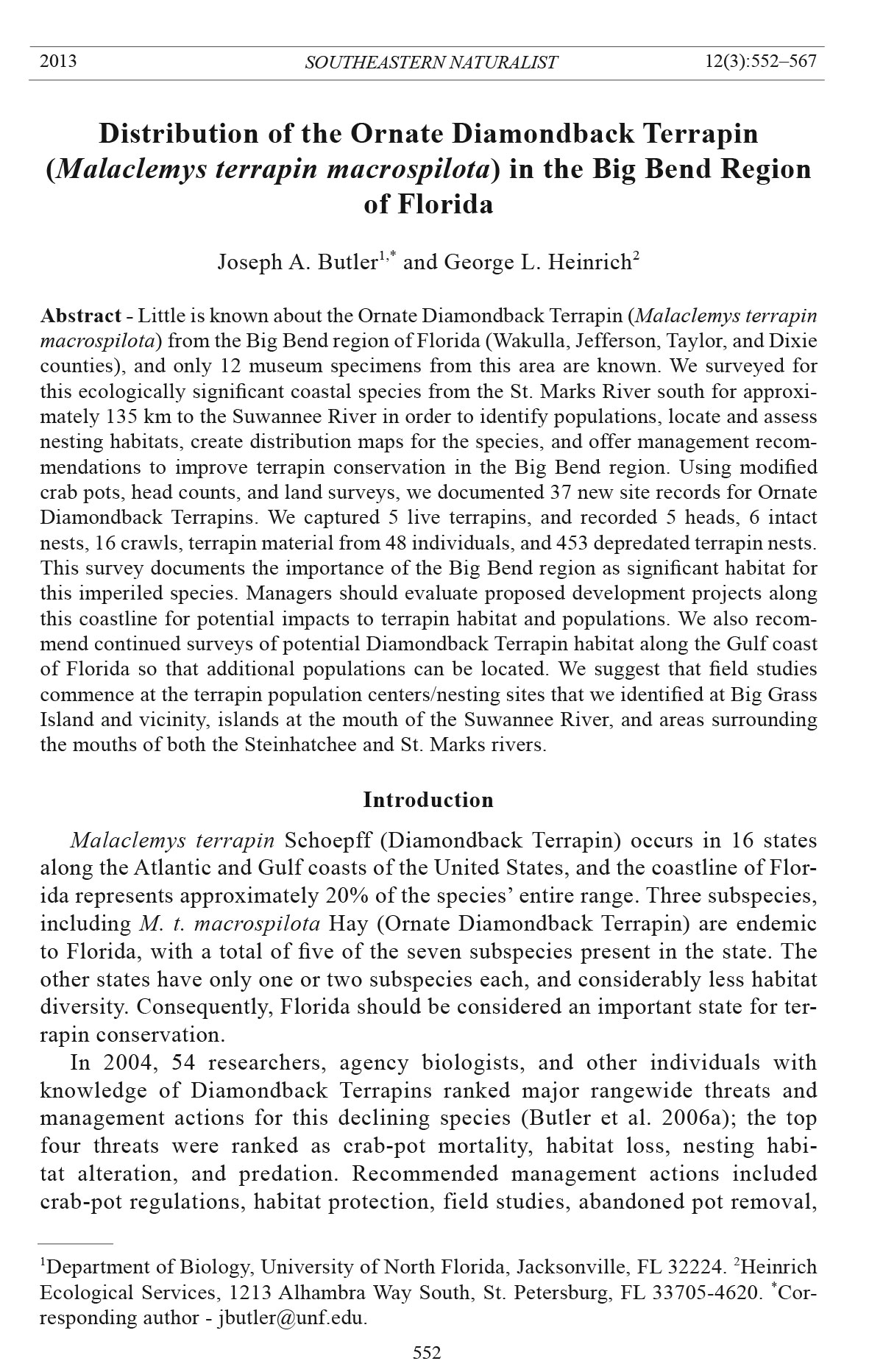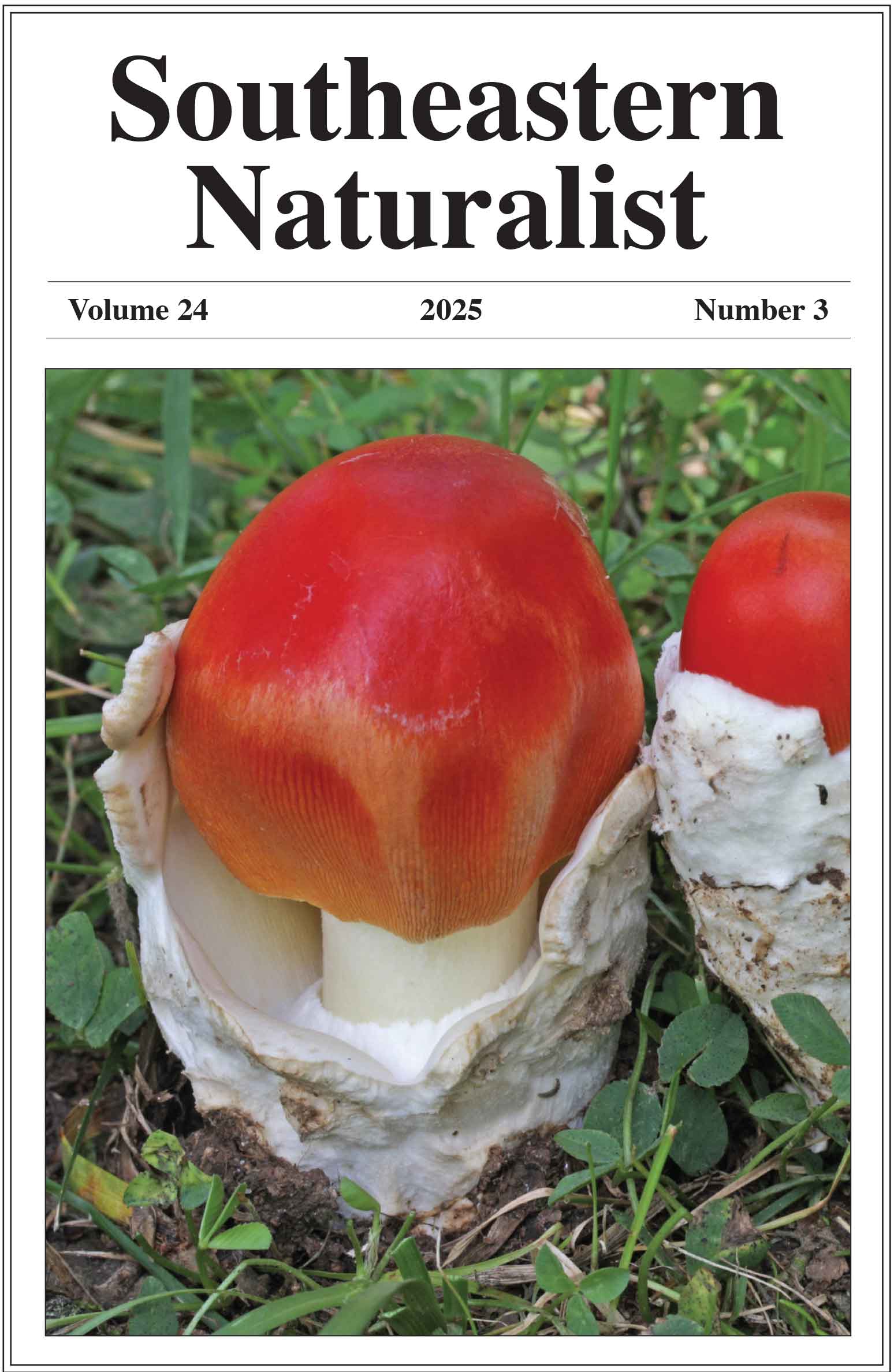J.A. Butler and G.L. Heinrich
2013 Southeastern Naturalist Vol. 12, No. 3
552
2013 SOUTHEASTERN NATURALIST 12(3):552–567
Distribution of the Ornate Diamondback Terrapin
(Malaclemys terrapin macrospilota) in the Big Bend Region
of Florida
Joseph A. Butler1,* and George L. Heinrich2
Abstract - Little is known about the Ornate Diamondback Terrapin (Malaclemys terrapin
macrospilota) from the Big Bend region of Florida (Wakulla, Jefferson, Taylor, and Dixie
counties), and only 12 museum specimens from this area are known. We surveyed for
this ecologically significant coastal species from the St. Marks River south for approximately
135 km to the Suwannee River in order to identify populations, locate and assess
nesting habitats, create distribution maps for the species, and offer management recommendations
to improve terrapin conservation in the Big Bend region. Using modified
crab pots, head counts, and land surveys, we documented 37 new site records for Ornate
Diamondback Terrapins. We captured 5 live terrapins, and recorded 5 heads, 6 intact
nests, 16 crawls, terrapin material from 48 individuals, and 453 depredated terrapin nests.
This survey documents the importance of the Big Bend region as significant habitat for
this imperiled species. Managers should evaluate proposed development projects along
this coastline for potential impacts to terrapin habitat and populations. We also recommend
continued surveys of potential Diamondback Terrapin habitat along the Gulf coast
of Florida so that additional populations can be located. We suggest that field studies
commence at the terrapin population centers/nesting sites that we identified at Big Grass
Island and vicinity, islands at the mouth of the Suwannee River, and areas surrounding
the mouths of both the Steinhatchee and St. Marks rivers.
Introduction
Malaclemys terrapin Schoepff (Diamondback Terrapin) occurs in 16 states
along the Atlantic and Gulf coasts of the United States, and the coastline of Florida
represents approximately 20% of the species’ entire range. Three subspecies,
including M. t. macrospilota Hay (Ornate Diamondback Terrapin) are endemic
to Florida, with a total of five of the seven subspecies present in the state. The
other states have only one or two subspecies each, and considerably less habitat
diversity. Consequently, Florida should be considered an important state for terrapin
conservation.
In 2004, 54 researchers, agency biologists, and other individuals with
knowledge of Diamondback Terrapins ranked major rangewide threats and
management actions for this declining species (Butler et al. 2006a); the top
four threats were ranked as crab-pot mortality, habitat loss, nesting habitat
alteration, and predation. Recommended management actions included
crab-pot regulations, habitat protection, field studies, abandoned pot removal,
1Department of Biology, University of North Florida, Jacksonville, FL 32224. 2Heinrich
Ecological Services, 1213 Alhambra Way South, St. Petersburg, FL 33705-4620. *Corresponding
author - jbutler@unf.edu.
553
J.A. Butler and G.L. Heinrich
2013 Southeastern Naturalist Vol. 12, No. 3
distribution surveys, and others. In Florida, distribution surveys were ranked
third for management actions needed (following field studies and crab-pot
regulations). To address these major threats and implement management
strategies, existing local terrapin populations should first be identified and
documented. Only then can biologists initiate field studies, and managers
determine if and where habitats are in danger and what actions will assure persistence
of these populations.
More recently, Florida’s State Wildlife Action Plan ranked Diamondback
Terrapins as one of the species of greatest conservation need (Florida Fish and
Wildlife Conservation Commission 2012). Regarding the protection and management
of Diamondback Terrapins throughout the state, the Florida Natural Areas
Inventory recommends that “statewide population surveys and monitoring are
sorely needed” (Hipes et al. 2001).
Several Diamondback Terrapin populations in Florida have been identified
and studied. Extensive studies have been conducted in northeastern Florida on
capture and population assessment, home range, nesting, hatching, and predation
of M. t. centrata Latreille (Carolina Diamondback Terrapin) (Butler 2000,
Butler 2002, Butler et al. 2004). Seigel (1980a, b, c; 1984) studied M. t. tequesta
Schwartz (Florida East Coast Diamondback Terrapin) on Merritt Island National
Wildlife Refuge on the central Atlantic coast, and follow-up studies suggested a
major decline in that population (Seigel 1993). Wood (1992) and Baldwin et al.
(2005) have worked with several M. t. rhizophorarum Fowler (Mangrove Diamondback
Terrapin) populations in the Florida Keys. Hart and McIvor (2008)
studied a Mangrove Diamondback Terrapin population in western Everglades
National Park. Additionally, populations of M. t. pileata Wied-Neuwied (Mississippi
Diamondback Terrapin) have been identified in the extreme western
panhandle region of Florida (L.R. O’Connor, University of Florida, Cantonment,
FL, pers. comm.). We know from previous research that Ornate Diamondback
Terrapins exist in Panacea and Cedar Key (Butler and Heinrich 2007), and that
populations occur at St. Martins Keys near Crystal River (Boykin, no date), Tarpon
Key in Tampa Bay (C.S. Boykin, Florida Department of Protection, Miami,
FL, pers. comm.), and the Sanibel Island area (C. Lechowicz, Sanibel-Captiva
Conservation Foundation, Sanibel, FL, pers. comm.). There are no published
records in the area between those sites; however, we expect that terrapins are
present in at least some areas.
A survey of 20 major natural history museums (Butler et al. 2006b) revealed
only 12 Diamondback Terrapin specimens from the entire Big Bend region located
in the northwestern Florida peninsula (Fig. 1). All but 1 of these records
represent collections of single individuals, and the most recent record is from
1988. Seemingly appropriate Diamondback Terrapin habitat is present, and
we believe the paucity of data from the Big Bend region is due to the relative
inaccessibility of the coastline, a circumstance that could prove beneficial to
terrapin conservation.
J.A. Butler and G.L. Heinrich
2013 Southeastern Naturalist Vol. 12, No. 3
554
In this study, we surveyed the Big Bend region of Florida for Ornate Diamondback
Terrapins. Our objectives were to identify populations of terrapins
throughout the area, locate and assess nesting habitats, create a series of maps of
the Big Bend region illustrating the above locations, and outline suggestions for
improving terrapin conservation.
Figure 1. Big Bend region of Florida between the St. Marks and Suwannee rivers. Collection
sites for 12 Ornate Diamondback Terrapin museum specimens recorded prior to this
study are indicated, as are towns or other sites from which we launched.
555
J.A. Butler and G.L. Heinrich
2013 Southeastern Naturalist Vol. 12, No. 3
Methods
Study area
The study area encompassed the Big Bend region of Florida from the St. Marks
River south approximately 135 km to the Suwannee River, including 4 counties:
Wakulla, Jefferson, Taylor, and Dixie (Fig. 1). In addition to the 2 bordering rivers,
the Aucilla, Econfina, Fenholloway, and Steinhatchee rivers also drain into
the northeastern Gulf of Mexico in this region. Most shorelines are composed of
saltmarsh, dominated by Spartina alterniflora Loisel (Smooth Cordgrass) and
Juncus roemerianus Scheele (Black Needlerush), and few sandy beaches are present
(Kruczynski et al. 1978). The marshes extend inland for several kilometers in
most areas and are penetrated by numerous tidal creeks. Wave action is classified
as “zero” and water is generally shallow, with low tides leaving many creeks and
near-shore areas empty (Tanner 1960). The study area shoreline has some protection
due to its location within the Big Bend Seagrasses Aquatic Preserve (BBSAP),
which includes the St. Marks National Wildlife Refuge (SMNWR), Big Bend
Wildlife Management Area (BBWMA), Econfina River State Park (ERSP), and the
Lower Suwannee National Wildlife Refuge.
During 2007–2009, we traveled to various areas in the Big Bend region for
a series of eight 5-day research trips during the months of May, June, and July.
A ninth expedition consisting of 9 days was undertaken in 2008. Our field bases
offered both lodging and boat ramp access, and we launched from SMNWR (SR
59), ERSP (SR 14), Spring Warrior Fish Camp (SR 361A), Keaton Beach (SR
361), Steinhatchee (SR 361), Horseshoe Beach (SR 351), Shired Island (SR 357),
and Suwannee (SR 349) (Fig. 1). When inclement weather prevented us from using
the boat, we traveled by car to accessible spots and conducted land surveys.
Modified crab pots
Lovich and Gibbons (1990) demonstrated that Diamondback Terrapins exhibit
a high degree of site fidelity; therefore, recording their presence in an area at
one point in time has predictive value for their subsequent presence. One method
we employed for establishing terrapin presence was using modified crab pots
to capture them (Butler 2002, Roosenburg et al. 1997). Terrapins are known to
enter crab pots used to capture Callinectes sapidus Rathbun (Blue Crabs), where
they become entrapped and will drown if not released (Grosse et al. 2009). We
cut the tops off of 6 commercial crab pots and modified them by installing PVC
pipe frames which extended trap heights to 1.2 m so that trapped terrapins could
surface for oxygen. We secured the pots by enclosing the frames in commercial
crab-pot mesh. Pots were baited with dead fish (Mugil sp. [mullet]), deployed
near shorelines on the first day of each survey trip, and anchored into the mud
with 4-m-long steel pipes. We trapped for 3 days giving us 18 trap-days at each
site, except during the third season when inclement weather and boat-related
mechanical problems precluded us from trapping. Previous studies using this
method showed that when terrapins are nearby, they are usually caught soon after
trap deployment (1–4 days; Butler 2002).
J.A. Butler and G.L. Heinrich
2013 Southeastern Naturalist Vol. 12, No. 3
556
Prior to the second and third seasons, we sent letters to all licensed Blue
Crab trappers (n = 105) throughout the Big Bend region requesting information
concerning local terrapin populations. We included a self-addressed, stamped
postcard to encourage their responses. Our goal was to gather location information
that might help guide us with trap placement, head counts, and land surveys.
Head counts
Capture of Diamondback Terrapins unequivocally demonstrates their presence,
but if there is little or no need to have terrapins in-hand, there are less
labor-intensive methods to assess populations (Harden et al. 2009). We performed
daytime visual surveys from a boat (4.9-m Carolina Skiff with a 30 hp
Yamaha motor) along shorelines, around near-shore islands, and in most creeks.
Adult terrapins rarely leave the water (except females to nest), but they surface
often for air when active, so we recorded their presence by counting heads as
we moved through areas at idle speed. We recorded GPS points for each sighting
using a hand-held unit (Garmin GPSMAP 76CSx).
Land surveys
From the boat, we searched shorelines for suitable terrapin nesting sites (i.e.,
areas above the high-tide line with exposed sand; Roosenburg 1994). Most often
we found these areas on Gulf islands or at river and creek mouths. Frequently,
sandy areas were obscured by tidal wrack, and we used shrubs as indicators of
sites with appropriate elevation and soils for nesting. We performed walking
surveys of beaches and shorelines that appeared promising as Diamondback
Terrapin nesting areas. At those sites we recorded terrapin presence as live
Diamondback Terrapins, intact nests, crawls, terrapin material (carcasses, bones,
and scutes), and depredated nests. We identified terrapin nesting areas by finding
nests depredated by Procyon lotor L. (Raccoon; Butler et al. 2004). In some
cases we were able to identify the tracks (crawls) left by female terrapins that
had come ashore to nest (Butler 2002). We recorded the dominant plant species
at each nesting site, and we occasionally captured female terrapins at these sites.
Latitude and longitude of all sites were recorded with a GPS un it.
Maps
We used all recorded GPS points to create a series of maps using ArcGIS 10.0
(Environmental Systems Research Institute, Redlands, CA). Maps include our
launch sites, all surveyed creeks and shorelines, museum records, all terrapins
located with head counts, individuals captured live, intact nests, crawls, terrapin
material, and depredated nests.
Results
Our survey of licensed Blue Crab trappers within the Big Bend region resulted
in the return of 11 postcards (10.5%): five indicating they had information on
terrapin locations and six stating that they had no information. We recorded 533
557
J.A. Butler and G.L. Heinrich
2013 Southeastern Naturalist Vol. 12, No. 3
observations of Ornate Diamondback Terrapin presence from 41 separate sites in
Wakulla, Taylor, and Dixie counties but none from Jefferson County. We considered
all terrapins or their signs recorded during this study to be new site records if
they were documented in areas without previously collected museum specimens.
Our survey established 37 new terrapin site records in the Big Bend region.
Modified crab pots
We captured no Diamondback Terrapins using the modified crab pots at any
location during 126 trap-days. Inclement weather and boat engine problems prevented
us from trapping during the third year of the study (200 9).
Head counts
We recorded 5 Diamondback Terrapins using head counts, all in Taylor County
during 2008, with 4 of those representing new site records (Table 1). Three
were seen at creek mouths (Eaglenest, Spring Warrior, and Crooked creeks), and
2 were observed in a lagoon at Dekle Beach (Fig. 2A). Time constraints and inclement
weather precluded us from performing head counts on every creek; however
we searched the majority of creeks, particularly those south of the Econfina
River (Figs. 2A, 2B, 2C, and 2D).
Land surveys
Of our 37 new site records, 33 were the result of land surveys (Table 1). Of
the 5 live female terrapins collected during land surveys, 3 were found as they
nested. Individual terrapins were captured at Spring Warrior Fish Camp, Sponge
Point, and Big Grass Island in Taylor County (Fig. 2A), Pepperfish Keys in Dixie
Table 1. Records of Ornate Diamondback Terrapins or their sign documented in the Big Bend region
of Florida during this study. Head counts were recorded from the boat; all other observations
were made during land surveys. Data from north and south of the Steinhatchee and Econfina River
State Park (ERSP) launch sites are presented separately.
Live Intact Terrapin Depredated New site
Launch sites Heads terrapins nests Crawls material nests records
2007
Horseshoe Beach 20 16 3
Shired Island 2 7 2
Suwannee 2 80 5
2008
Spring Warrior 1 1 2 4 2 3
Keaton Beach 3 2 1 8 128 9
Steinhatchee (North) 1 1 1 4 118 5
Steinhatchee (South) 1 1 11 6 64 5
2009
St. Marks 1 1 2 26 3
ERSP (North) 1 14 1
ERSP (South) 1 1
Totals 5 5 6 16 48 453 37
J.A. Butler and G.L. Heinrich
2013 Southeastern Naturalist Vol. 12, No. 3
558
County (Fig. 2B), and Palmetto Island in Wakulla County (Fig. 2C); all represent
new site records.
Figure 2. Detailed subregions of Florida between the St. Marks and Suwannee rivers indicating
the sites where terrapins or their sign were recorded. (A) region between Eaglenest
and Big Bear creeks, (B) region between Steinhatchee and Pepperfish Keys, (C) region
between the St. Marks and Fenholloway rivers, and (D) region between Horseshoe Beach
and the Suwannee River. Polygons surround creeks, shorelines, and islands surveyed.
Legend: ● = museum records, * = launch sites; and ♦ = terrapin sign/records.
559
J.A. Butler and G.L. Heinrich
2013 Southeastern Naturalist Vol. 12, No. 3
We located 6 intact nests: 2 by following terrapin crawls, 1 without a crawl,
and 3 when nesting terrapins were captured as described above. We followed
terrapin crawls to 2 intact nests at the end of the road at Ezell Creek (Fig. 2A),
representing another new site record. We observed another intact nest deposited
in tidal wrack on a wooded island at the mouth of the Steinhatchee River
(Fig. 2B). In addition to the 2 crawls listed above, we found a third one at Ezell
Creek, 1 at another island at the mouth of the Steinhatchee River, and 11 on the
unnamed northwestern-most island of the Pepperfish Keys (Fig. 2B). However,
these crawls were not associated with identifiable nests.
We found terrapin material at 18 locations representing 48 animals (Table 1);
findings varied from a single scute, skulls, bones from shells, and intact shells, to
recently dead females. Eleven of these were new sites. We collected single bones
on the shoreline of the Cedar Point Trail at the SMNWR boat ramp and on the
trail east of the lighthouse (Fig. 2C). We found bones or carcasses from multiple
terrapins at Adams Beach, the area between Keaton Beach and Salt Creek, Dark
Island (Fig. 2A), the wooded island at the mouth of the Steinhatchee River, Tater
Island, Bull Cove (Fig. 2B), the north bank of Double Barrel Creek, and the north
shoreline directly across the lagoon from the city park at Horseshoe Beach (Fig.
2D). The latter area produced material of 20 adult female terrapins. The two
specimens found at Double Barrel Creek were fairly fresh, apparently the victims
of Raccoon predation. This area had numerous Raccoon-depredated terrapin
nests, and both turtles were on their backs with flesh torn away from around their
hindlimbs (one with eggshells nearby; Seigel 1980a). At Ezell Creek, 1 terrapin
had apparently been run over by a vehicle, and eggshells were scattered from the
carcass suggesting that a Raccoon had been involved either before or after the
automobile incident. We found one dead hatchling at Yates Creek, adjacent to
Ezell Creek. Another small terrapin with two annuli was found dead and covered
with Solenopsis invicta Buren (Red Imported Fire Ant) at Keaton Beach. At the
BBWMA, Hickory Mound Unit, we found a female terrapin that had been dead
for a day or two on Coker Road on the southern border of the impoundment, just
west of Smith-McCullah Creek (Fig. 2C).
We found 453 depredated terrapin nests at 39 locations, representing 16 more
new site records (Table 1). We did not spend equal time searching at each location.
We recorded 17 depredated nests at or near the mouth of the St. Marks River,
including the shoreline immediately to the west of the lighthouse, Sprague Island,
and a section of eastern shoreline approximately 3.5 km north of the river mouth
and east of an unnamed island (Fig. 2C). East of the St. Marks River, we found
depredated nests on Palmetto Island and the shoreline from Porpoise Creek east
to Little Grooms Creek. Adams Beach yielded 27 depredated nests; the nesting
area is about 200 m north of the termination of SR 361 (Fig. 2A). We also located
21 depredated nests on Sponge Point, just south of Keaton Beach. The singlemost
productive site for depredated nests was Big Grass Island. We visited the
island on 30 May 2008, recorded 61 depredated nests, removed all eggshells, and
then we returned on 17 June 2008 and recorded 72 new depredated nests. About 3
km south of Big Grass Island, at Fishermans Rest, we logged 12 depredated nests.
J.A. Butler and G.L. Heinrich
2013 Southeastern Naturalist Vol. 12, No. 3
560
We documented 52 depredated nests at the mouth of the Steinhatchee River, most
located on Lazy Island along the south shoreline, but we found some on the two
easternmost unnamed islands in the center of the mouth and also along the north
shoreline of the mouth (Fig. 2B). At Pepperfish Keys, the unnamed northwesternmost
island had 3 depredated nests, and the adjacent mainland shoreline had 10
more. We counted an additional 20 depredated nests at Tater Island. A very small
unnamed beach, perhaps only 100 m long and 5 m wide, at the end of SR 351
in Horseshoe Beach had 14 depredated nests (Fig. 2D). We found 31 depredated
nests on the north shoreline at the mouth of Double Barrel Creek in an area about
75 m long and 20 m wide. At the mouth of the Suwannee River, on its surrounding
islands, we recorded 79 more depredated nests.
Nesting beach characteristics
The shrubs most frequently associated with terrapin nesting areas were Iva
frutescens L. (Marsh Elder) and Lycium carolinianum Walt. (Christmas Berry).
We used the larger, shrubby vegetation as possible nest-site indicators. Other
smaller plants usually found with them were Batis maritima L. (Saltwort), Salicornia
perennis Mill. (Perennial Glasswort), Borrichia frutescens L. (Sea-oxeye),
and Distichlis spicata (L.) Greene (Salt Grass); in areas adjacent to nesting sites
Smooth Cordgrass and/or Black Needlerush were always found. At some larger
sites we recorded trees such as Juniperus silicicola (Small) Bailey (Southern Red
Cedar) and Sabal palmetto (Walter) Lodd (Sabal Palm), but these did not appear
to be necessary for nesting, and indeed most nesting areas did not have them.
Discussion
Our modified crab pots were ineffectual, and we captured no Diamondback
Terrapins with them. Because this technique had been used successfully in the
past (Butler 2000, 2002; Hoyle and Gibbons 2000; Mann 1995; Roosenburg et al.
1997), we expected similar results. For logistical reasons, primarily storage and
transportation, we deployed the pots without information on whether our target
species was nearby. The modified crab pots were arduous to build, challenging
to transport on land and water, unwieldy to deploy, and time-consuming to check
daily. In future surveys we suggest using such modified pots only in areas where
terrapins are suspected to occur.
Although 4 of our new site records (10.8%) came from seeing heads at the
surface, this technique had an inherent flaw in that head counts are more effective
at low tide when terrapins are concentrated in smaller areas (Harden et al.
2009). However, in the Big Bend region most creeks are either too shallow for
boat passage or drained at low tide, so we were forced to perform our counts at
high tide when, even if terrapins are nearby, they are more dispersed and perhaps
feeding in the flooded marshes (Tucker et al. 1995). Many people in the Big Bend
region travel the near-shore areas and tidal creeks by airboat, but this would be
impractical for counting heads. Head counts would likely be more successful if
researchers surveyed from kayaks or canoes at low tide.
561
J.A. Butler and G.L. Heinrich
2013 Southeastern Naturalist Vol. 12, No. 3
Despite the substantial time commitment, it is clear that land surveys were our
most successful method of recording terrapin presence. Diamondback Terrapins
rarely leave the water except for nesting. Therefore, when terrapin evidence is
found on land it often signals the presence of a nesting site. Potential nesting areas
can be identified from the boat at some distance (approximately 0.5–1.0 km)
if the researcher can see a sandy beach or differentiate the shrubby vegetation
from the Smooth Cordgrass and Black Needlerush. Land surveys of these potential
sites can then be conducted. Additionally, some coastal nesting areas can be
approached by car, which is ideal for days with inclement weather.
Nesting sites offer many indicators of terrapin presence including the most
obvious evidence, depredated nests (Auger and Giovannone 1979, Burger 1977,
Butler et al. 2004, Feinberg and Burke 2003, Goodwin 1994, Roosenburg 1992).
Additionally, predators sometimes kill nesting female terrapins, and carcasses
or bones are left at these sites (Seigel 1980a). Terrapin crawls can be identified
under appropriate sand conditions, and the crawls can sometimes be followed to
intact nests (Butler et al. 2004). Occasionally, researchers may encounter live
females that are moving to or from nesting sites, or actually nesting.
We identified 4 significant terrapin sites: Big Grass Island, the mouths of the
Suwannee and Steinhatchee rivers, and the St. Marks River east to Palmetto Island
and Porpoise Creek. During two separate trips to Big Grass Island (Fig. 2A),
we found a live terrapin, terrapin material, and numerous depredated nests. It is
noteworthy that one of the three Pepperfish Keys islands is named Big Grassy
Island, but it lacks appropriate nesting characteristics. Further, we recorded fairly
consistent terrapin presence in surrounding areas all the way to Eaglenest Creek,
some 26 km north (records at Eaglenest, Spring Warrior, Yates, and Ezell creeks,
Adams, Dekle, and Keaton beaches, Dark Island, Sponge Point, Hagens Cove,
and Crooked Creek), and 1.5 km south to Big Bear Creek. This is the longest
stretch of coastline where we documented terrapin records. Inclement weather
between Big Bear and Bivens creeks to the south hampered our activities on several
days, so we were unable to investigate Clay, Dallus, Bayview, Jack, and Salt
creeks. It might be valuable to survey these five creeks in the future.
Another important terrapin nesting area is the mouth of the Suwannee River,
where we identified depredated nests on most of the islands at its mouth including
Goodson, Little Bradford, Palm, and an unnamed one (Fig. 2D). Proceeding
north for approximately the next 10 km, we found more terrapin evidence on the
north bank of Double Barrel and the south bank of Bumblebee creeks, and on Little
Pine, Big Pine, and Shired islands. We surveyed all creeks from Shired Island north
to Horseshoe Beach and recorded depredated nests on the shoreline of Fishbone
Creek. At Horseshoe Beach, we documented nesting areas on opposite shorelines
of a lagoon just north of Horseshoe Point. Time limitations prevented us from
searching areas between Horseshoe Beach and Pepperfish Keys to the north.
The mouth of the Steinhatchee River also attracts nesting terrapins (Fig. 2B).
We documented terrapin sign on the river mouth’s unnamed northern shoreline,
its easternmost spoil islands and on Lazy Island, at the southern edge of the river
J.A. Butler and G.L. Heinrich
2013 Southeastern Naturalist Vol. 12, No. 3
562
mouth. However, we found no other evidence of terrapins until Tater Island, nearly
10 km south, despite the presence of seemingly good nesting habitat at the mouth
of Rocky Creek. From there to the south, we recorded terrapin evidence at Bull
Cove, Bowlegs Point, the mainland east of Pepperfish Keys, and the unnamed
northwestern-most island of the Pepperfish Keys. This latter island appears to be
a bird rookery, and we identified numerous Eudocimus albus L. (White Ibis), Casmerodius
albus L. (Great Egret), Egretta tricolor Muller (Tricolored Heron), and
Bubulcus ibis L. (Cattle Egret) in residence. We have noted terrapin presence at
rookery islands in the past at Tarpon Key and Alafia Bank in Tampa Bay (J.A. Butler
and G.L. Heinrich, unpubl. data). We found 3 depredated nests on this rookery
island, along with 11 crawls and a nesting female and her nest; however, we suspect
this island is more important than even these data suggest. The other two Pepperfish
islands do not have appropriate habitat for terrapin nesting.
A fourth important terrapin nesting area is the St. Marks River east to Palmetto
Island and Porpoise Creek (Fig. 2C). We found nesting sites around the river
mouth, on Sprague Island (our westernmost survey area), the shoreline about
3.5 km upriver, and on the Gulf shoreline west of the lighthouse. Further east,
Palmetto Island supports nesting, as does the shoreline around Porpoise Creek.
This survey identified 4 important terrapin sites that warrant further study and
protection, but areas that we did not cover (Fig. 2), either due to inclement weather
or time constraints, are also likely to support terrapins. Conversely, it would be
beneficial to determine why terrapins were not found in some areas adjacent to
existing populations. One of the crab trappers surveyed indicated that terrapins
were so abundant in the region during the late 1940s that they were commercially
harvested. He added that some areas formerly known to support terrapins now appear
to be devoid of the turtles. Previous anthropogenic threats such as commercial
harvest of the species could have contributed to localized extirpations.
Management and research recommendations
The primary objective of the current study was to document previously unknown
terrapin populations in the Big Bend region. In addition, during the course
of our work we identified specific management and research needs. The four notable
terrapin sites identified above (Big Grass Island, the mouths of the Suwannee
and Steinhatchee rivers, and the St. Marks River east to Palmetto Island and
Porpoise Creek) all are likely to yield valuable data about terrapin populations
and would be conducive to further research because of their ease of access, appropriate
accommodations, and boat launching facilities.
Predation, habitat loss, and mortality in crab pots are the top 3 threats to
Diamondback Terrapin populations in Florida (Butler et al. 2006a), and we documented
all of them in the study area. We know from tracks and scat that Raccoons
are the major terrapin predators throughout the Big Bend region; over 90% of
our observations of terrapin material and depredated nests were attributable to
Raccoons. Furthermore, we found 4 Raccoon scats containing terrapin eggshells
on Sprague Island; this was our only such observation during the course of this
563
J.A. Butler and G.L. Heinrich
2013 Southeastern Naturalist Vol. 12, No. 3
survey. Feinberg and Burke (2003) and Burke et al. (2009) noted this occurrence
in New York and claimed that some Raccoons change their eating behavior as the
summer progresses, swallowing more eggshells than earlier in the season. This
phenomenon could be tested on Sprague Island. Terrapin populations throughout
the Big Bend region would benefit from an ongoing Raccoon control program
(Munscher et al. 2012).
At Shired Island, we noted excessive habitat damage due to Sus scrofa L.
(Feral Hog) digging. Although we did not directly associate this with damage to
Diamondback Terrapin nests, Feral Hogs are known to destroy sea turtle nests in
some areas (Lewis et al. 1994). The Shired Island area was high and sandy, with
seemingly appropriate vegetation for terrapin nesting. We noted Feral Hog damage
at numerous other areas throughout the study, so their populations are apparently
thriving in the Big Bend region. Feral Hogs are opportunistic omnivores,
highly prolific, and damaging to many forms of endemic wildlife (Ditchkoff and
West 2007). Therefore, we recommend that their dietary habits be studied and
that populations be monitored/controlled.
The St. Marks River area would provide a unique opportunity to study potential
predation by another Florida mammal. At a site about 3.5 km upriver on
the eastern shoreline, we recorded Lynx rufus Schreber (Bobcat) bones and scat
representing at least two individuals, along with several depredated terrapin
nests. Because we observed no Raccoon sign in this area, it would be valuable
to determine if Bobcats are terrapin nest predators. Although they have not been
implicated as such, Bobcats have been documented as sea turtle nest predators
(Martin et al. 2005).
Following predation, habitat loss is the next major threat to Florida Diamondback
Terrapin populations. Currently, the Big Bend region is inhabited by a
comparatively sparse human population that is centered at higher elevations and
along some major rivers, including the towns of St. Marks, Keaton Beach, Horseshoe
Beach, Suwannee, and Steinhatchee—the largest town, with a population of
1047 (2010 census; US Census Bureau 2011). Many businesses in the area focus on
tourism and recreational fishing (off-shore charters and the summer scallop season).
Numerous houses and condominiums in these towns are vacation homes for people
living elsewhere. The lack of sandy beaches is the likely reason that this area has not
attracted more visitors and development. The limited development in the region at
this time provides an opportunity to protect this nearly pristine habitat. As humans
move into and develop coastal areas, they usually do so at the higher elevation spots,
and we have shown that these are often extremely important nesting areas for Diamondback
Terrapins. Also, coastal homeowners frequently protect their property
from tidal erosion by depositing rip-rap or otherwise hardening the shoreline. Such
coastal armoring prevents aquatic turtles from accessing sandy shorelines for nesting
(Mosier 1998). This practice is apparent at Jug Island and Dekle Beach. In such
cases, we are uncertain whether terrapins are capable of locating alternate nesting
sites. Butler et al. (2004) found that some terrapins in northeastern Florida traveled
nearly 10 km from their normal ranges to nest on a specific beach.
J.A. Butler and G.L. Heinrich
2013 Southeastern Naturalist Vol. 12, No. 3
564
In 2007, state and federal agencies rejected plans for the proposed Magnolia
Bay Marina and Resort, which would have destroyed approximately 40 ha of
saltmarsh and excavated a channel 3 km long and 30 m wide through the BBSAP
at Boggy Bay, which is located between Dekle and Keaton beaches. This site
is within the shoreline we have identified as the longest continuous stretch of
terrapin records in the Big Bend region. The project was abandoned under pressure
from local environmental groups, fishermen, and various state and federal
environmental agencies. The fact that such a proposal was offered, however,
signals that interest in developing the area is expanding. It will be necessary for
the environmental community to be vigilant, cautious, and conservative about
development along the Big Bend coastline.
Radio telemetry studies are needed to provide information concerning feeding
sites, nesting forays, winter behavior, and home range (Butler 2002). These data
would be valuable for identifying sites vital to the protection and conservation
of coastal aquatic habitats used by Diamondback Terrapins. Because we demonstrated
that terrapin distribution in the Big Bend region was not contiguous, both
radio telemetry and genetic studies (Hart 2005) would also increase our understanding
of terrapin populations, and perhaps allow delineation of more discrete
population boundaries.
Although Blue Crab trapping is not extensive in the areas where we worked,
we still recommend the use of bycatch reduction devices (BRDs) on crab pots
to prevent terrapins from entering the traps and drowning (Butler and Heinrich
2007). Our modified crab pots were unsuccessful at trapping terrapins, but if
unmodified pots are placed in areas inhabited by terrapins, then large numbers
can enter and drown (Grosse et al. 2009). We know that approximately 73% of
terrapins can be prevented from entering crab pots with BRDs and we continue
to urge their required use on commercial and recreational crab pots in Florida
waters (Butler and Heinrich 2007).
Additionally, when searching on land at Hagens Cove we encountered a man
systematically collecting Uca sp. (fiddler crabs). He erected a temporary barrier
with aluminum flashing and then herded thousands of crabs toward it where
they were easily collected. Upon questioning, he informed us that he sold them
to bait dealers all along the Atlantic coast as far north as New York City. We
are concerned that if he indeed supplies multiple dealers on the east coast, and
if take is unlimited, it could have a deleterious effect on Gulf coast fiddler crab
populations. Fiddler crabs are prey for numerous fishes, birds, and mammals, and
have been identified as a major food item for Diamondback Terrapins (Butler et
al. 2012). Although currently legal with a permit, such collecting in state aquatic
preserves should be restricted.
This 3-year survey was the initial step toward the development of a conservation
plan for this little-known species. We recommend further studies at the
sites that we identified as the most important Diamondback Terrapin population
centers/nesting sites.
565
J.A. Butler and G.L. Heinrich
2013 Southeastern Naturalist Vol. 12, No. 3
Acknowledgments
This study was made possible through funding from the Florida Fish and Wildlife
Conservation Commission’s (FWC) Nongame Wildlife Trust Fund, project number
NG06-021. We had a Special Activity License (07SR-159) to use modified crab pots
and an FWC Special Purpose Permit (#WX07118) to capture Diamondback Terrapins.
Wildlife Biologist Michael Keys arranged for us to have a temporary Special Use Permit
while working in the St. Marks National Wildlife Refuge. The project was approved by
the University of North Florida’s (UNF) Institutional Animal Care and Use Committee
(permit #07-002). We thank Kyle Miller (FWC) for providing a list of Blue Crab license
holders and the following crabbers for information concerning terrapin locations and
other suggestions: Billy Boone, Jerry Lane, Stuart Prescott, and Stuart L. Tomlinson. We
thank Jessica A. Waltman for assistance with building the modified crab pots and Benjamin
K. Atkinson for joining us in the field. We are thankful to Katya Schuster-Barber for
creating the ArcGIS maps from our recorded GPS points, and to David Wilson of UNF’s
Center for Instruction and Research Technology for his enhancement of the maps. During
our first season, James Butler of Compass Realty in Horseshoe Beach helped us procure
lodging and allowed us to leave our boat on his property between trips. Glenn Sentner of
Beach Realty Gulf Coast in Keaton Beach did the same for us during our second year, and
Bonnie Kinsey of Bonnie’s Camp at Econfina River State Park helped us similarly during
the last year. We thank Robin Rutledge, Trish Brown, Aaron Lowe, and Tom Bartlett for
keeping the boat in running condition throughout the study.
Literature Cited
Auger, P.J., and P. Giovannone. 1979. On the fringe of existence: Diamondback Terrapins
at Sandy Neck. Cape Naturalist 8:44–58.
Baldwin, J.D., L.A. Latino, B.K. Mealey, G.M. Parks, and M.R.J. Forstner. 2005. The
Diamondback Terrapin in Florida Bay and the Florida Keys: Insights into turtle conservation
and ecology. Pp. 180–186, In W.E. Meshaka, Jr., and K.J. Babbitt (Eds.).
Amphibians and Reptiles: Status and Conservation in Florida. Krieger Publishing
Company, Malabar, FL
Boykin, C.S. No date. The status and demography of the Ornate Diamondback Terrapin
(Malaclemys terrapin macrospilota) within the St. Martins Marsh Aquatic Preserve.
Available online at http://www.dep.state.fl.us/coastal/sites/stmartins/pub/SMM_Terrapin_
Report.pdf. Accessed 7 July 2013.
Burger, J. 1977. Determinants of hatching success in Diamondback Terrapin, Malaclemys
terrapin. American Midland Naturalist 97:444–464.
Burke, R.L., S.M. Felice, and S.G. Sobel. 2009. Changes in Raccoon (Procyon lotor)
predation behavior affects turtle (Malaclemys terrapin) nest census. Chelonian Conservation
and Biology 8:208–211.
Butler, J.A. 2000. Status and distribution of the Carolina Diamondback Terrapin, Malaclemys
terrapin centrata, in Duval County. Final Report, Florida Fish and Wildlife
Conservation Commission, Tallahassee, FL.
Butler, J.A. 2002. Population ecology, home range, and seasonal movements of the Carolina
Diamondback Terrapin, Malaclemys terrapin centrata, in northeastern Florida.
Final Report, Florida Fish and Wildlife Conservation Commission, Tallahassee, FL.
Butler, J.A., and G.L. Heinrich. 2007. The effectiveness of bycatch reduction devices on
crab pots at reducing capture and mortality of Diamondback Terrapins (Malaclemys
terrapin) in Florida. Estuaries and Coasts 30:179–185.
J.A. Butler and G.L. Heinrich
2013 Southeastern Naturalist Vol. 12, No. 3
566
Butler, J.A., C. Broadhurst, M. Green, and Z. Mullin. 2004. Nesting, nest predation and
hatchling emergence of the Carolina Diamondback Terrapin, Malaclemys terrapin
centrata, in northeastern Florida. American Midland Naturalist 152:145–155.
Butler, J.A., G.L. Heinrich, and R.A. Seigel. 2006a. Third workshop on the ecology, status,
and conservation of Diamondback Terrapins (Malaclemys terrapin): Results and
recommendations. Chelonian Conservation and Biology 5:331–334.
Butler, J.A., R.A. Seigel, and B.K. Mealey. 2006b. Malaclemys terrapin—Diamondback
Terrapin. Pp. 279–295, In P.A. Meylan (Ed.). Biology and Conservation of Florida
Turtles. Chelonian Research Monographs Number 3.
Butler, J.A., G.L. Heinrich, and M.L. Mitchell. 2012. Diet of the Carolina Diamondback
Terrapin (Malaclemys terrapin centrata) in northeastern Florida. Chelonian Conservation
and Biology 11:124–128.
Ditchkoff, S.S., and B.C. West. 2007. Ecology and management of Feral Hogs. Human-
Wildlife Interactions 1:149–151.
Feinberg, J.A., and R.L. Burke. 2003. Nesting ecology and predation of Diamondback
Terrapins, Malaclemys terrapin, at Gateway National Recreation Area, New York.
Journal of Herpetology 37:517–526.
Florida Fish and Wildlife Conservation Commission. 2012. Florida’s state wildlife action
plan. Available at http://myfwc.com/conservation/special-initiatives/fwli/actionplan/.
Accessed on 23 January 2012.
Goodwin, C.C. 1994. Aspects of nesting ecology of the Diamondback Terrapin (Malaclemys
terrapin) in Rhode Island. M.Sc. Thesis. University of Rhode Island, South
Kingstown, RI. 84 pp.
Grosse, A.M., J.D. van Dijk, K.L. Holcomb, and J.C. Maerz. 2009. Diamondback Terrapin
mortality in crab pots in a Georgia tidal marsh. Chelonian Conservation and
Biology 8:98–100.
Harden, L.A., S.E. Pittman, J.W. Gibbons, and M.E. Dorcas. 2009. Development of a
rapid-assessment technique for Diamondback Terrapin (Malaclemys terrapin) populations
using head-count surveys. Applied Herpetology 6:237–245.
Hart, K.M. 2005. Population biology of Diamondback Terrapins (Malaclemys terrapin):
Defining and reducing threats across their geographic range. Ph.D. Dissertation. Duke
University, Durham, NC. 235 pp.
Hart, K.M., and C.C. McIvor. 2008. Demography and ecology of Mangrove Diamondback
Terrapins in a wilderness area of Everglades National Park, Florida. Copeia
2008:200–208.
Hipes, D., D.R. Jackson, K. NeSmith, D. Printiss, and K. Brandt. 2001. Field Guide to the
Rare Animals of Florida. Florida Natural Areas Inventory, Tallahassee, FL.
Hoyle, M.E., and J.W. Gibbons. 2000. Use of a marked population of Diamondback Terrapins
(Malaclemys terrapin) to determine impacts of recreational crab pots. Chelonian
Conservation and Biology 3:735–737.
Kruczynski, W.L., C.B. Subrahmanyam, and S.H. Drake. 1978. Studies on the plant community
of a north Florida salt marsh: Part 1. Primary production. Bulletin of Marine
Science 28:316–334.
Lewis, T.E., G.O. Bailey, and H.L. Edmiston. 1994. Effects of predator control on sea
turtle nest success on the barrier islands of Apalachicola Bay. Pp. 242–243, In K.A.
Bjorndal, A.B. Bolten, D.A. Johnson, and P.J. Eliazar (Eds.). Proceedings of the
Fourteenth Annual Symposium on Sea Turtle Biology and Conservation. NOAA
Technical Memorandum NMFS-SEFSC-351.
Lovich, J.E., and J.W. Gibbons. 1990. Age at maturity influences adult sex ratio in the
turtle Malaclemys terrapin. Oikos 59:126–134.
567
J.A. Butler and G.L. Heinrich
2013 Southeastern Naturalist Vol. 12, No. 3
Mann, T.M. 1995. Population surveys for Diamondback Terrapins (Malaclemys terrapin)
and Gulf Salt Marsh Snakes (Nerodia clarkii clarkii) in Mississippi. Mississippi Museum
of Natural Science Technical Report Number 37, Jackson, MS.
Martin, R.E., R.M. Engeman, H.T. Smith, C.K. Crady, M. Stahl, and B. Constantin.
2005. Cheloniidae (marine turtle). Nest predation by Bobcats. Herpetological Review
36:56–57.
Mosier, A.E. 1998. The impact of coastal armoring structures on sea turtle nesting behavior
at three beaches on the east coast of Florida. Unpubl. M.Sc. Thesis. University of
South Florida, Tampa, FL. 112 pp.
Munscher, E.C., E.H. Kuhns, C.A. Cox, and J.A. Butler. 2012. Decreased nest mortality
for the Carolina Diamondback Terrapin (Malaclemys terrapin centrata) following
removal of Raccoons (Procyon lotor) from a nesting beach in northeastern Florida.
Herpetological Conservation Biology 7:167–184.
Roosenburg, W.M. 1992. Life history consequences of nest site choice by the Diamondback
Terrapin, Malaclemys terrapin. Ph.D. Dissertation. University of Pennsylvania,
Philadelphia, PA. 206 pp.
Roosenburg, W.M. 1994. Nesting habitat requirements of the Diamondback Terrapin: A
geographic comparison. Wetland Journal 6:8–11.
Roosenburg, W.M., W. Cresko, M. Modesitte, and M.B. Robbins. 1997. Diamondback
Terrapin (Malaclemys terrapin) mortality in crab pots. Conservation Biology
11:1166–1172.
Seigel, R.A. 1980a. Predation by Raccoons on Diamondback Terrapins, Malaclemys terrapin
tequesta. Journal of Herpetology 14:87–89.
Seigel, R.A. 1980b. Courtship and mating behavior of the Diamondback Terrapin Malaclemys
terrapin tequesta. Journal of Herpetology 14:420–421.
Seigel, R.A. 1980c. Nesting habits of Diamondback Terrapins (Malaclemys terrapin)
on the Atlantic coast of Florida. Transactions of the Kansas Academy of Sciences
83:239–246.
Seigel, R.A. 1984. Parameters of two populations of Diamondback Terrapins (Malaclemys
terrapin) on the Atlantic coast of Florida. Pp. 77–87, In R.A. Seigel, L.E. Hunt,
J.L. Knight, L. Malaret, and N.L. Zuschlag (Eds.). Vertebrate Ecology and Systematics:
A Tribute to Henry S. Fitch. Special Publication Number 10. Museum of Natural
History, The University of Kansas, Lawrence, KS.
Seigel, R.A. 1993. Apparent long-term decline in Diamondback Terrapin populations at
the Kennedy Space Center, Florida. Herpetological Review 24:102–103.
Tanner, W.F. 1960. Florida coastal classification. Transactions of the Gulf Coast Association
of Geological Societies 10:259–266.
Tucker, A.D., N.N. FitzSimmons, and J.W. Gibbons. 1995. Resource partitioning by the
estuarine turtle Malaclemys terrapin: Trophic, spatial, and temporal foraging constraints.
Herpetologica 51:167–181.
US Census Bureau. 2011. Interactive population map. Available online at http://www.
census.gov/2010census/popmap/. Accessed on 13 August 2013
Wood, R.C. 1992. Mangrove Terrapin. Pp. 204–209, In P.E. Moler (Ed.) Rare and Endangered
Biota of Florida. Vol. III. Amphibians and Reptiles. University Press of Florida,
Gainesville. FL.














 The Southeastern Naturalist is a peer-reviewed journal that covers all aspects of natural history within the southeastern United States. We welcome research articles, summary review papers, and observational notes.
The Southeastern Naturalist is a peer-reviewed journal that covers all aspects of natural history within the southeastern United States. We welcome research articles, summary review papers, and observational notes.